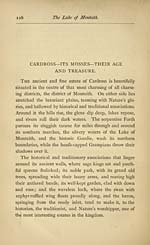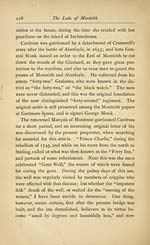Summer at the Lake of Monteith
(141) Page 127
Download files
Complete book:
Individual page:
Thumbnail gallery: Grid view | List view

Cardross. 127
Cardross, in Gaelic, signifies "The Fort on the Promon-
tory." It was originally a Roman station, and on each
side of the mansion-house can yet be seen the old Roman
pathway. During the great historic period, Cardross was
the haunt of many of the greatest men in Scottish history.
King Robert Bruce spent some time here, between the
time of his coronation and the battle of Bannockburn; and
one account says he slept in the house the night previous
to his great victory. Some historians state also that the
renowned king died here; but that event, I am inclined to
think, happened at Cardross in Dumbartonshire. Bruce's
sword is still carefully preserved in Cardross house, and
this extraordinary weapon is traditionally stated to have
been left by Bruce on one of his visits. Whether or not it
belonged to the hero-king can never be correctly known,
but there can be little doubt that it is a sword of the
period. It measures over all 6 feet 2J inches, blade 4
feet 7|- inches, breadth at hilt z\ inches, and weighs no
less than 10 lbs.
George Buchanan, the great Scottish historian, spent his
boyhood on the estate of Cardross. George's father having
died in early life, the family was taken in charge by James
Heriot, their maternal uncle, who leased two farms from
the earl of Mar for behoof of the widow and family. The
lease, dated and signed, is still preserved among the Car-
dross papers. John, seventh Earl of Mar, along with
James VI., was afterwards educated by George Buchanan.
Rather curious that the King of Scotland and an earl's
son should be educated by an orphan boy, the son of a
tenant on Cardross estate ! Queen Mary was a frequent
Cardross, in Gaelic, signifies "The Fort on the Promon-
tory." It was originally a Roman station, and on each
side of the mansion-house can yet be seen the old Roman
pathway. During the great historic period, Cardross was
the haunt of many of the greatest men in Scottish history.
King Robert Bruce spent some time here, between the
time of his coronation and the battle of Bannockburn; and
one account says he slept in the house the night previous
to his great victory. Some historians state also that the
renowned king died here; but that event, I am inclined to
think, happened at Cardross in Dumbartonshire. Bruce's
sword is still carefully preserved in Cardross house, and
this extraordinary weapon is traditionally stated to have
been left by Bruce on one of his visits. Whether or not it
belonged to the hero-king can never be correctly known,
but there can be little doubt that it is a sword of the
period. It measures over all 6 feet 2J inches, blade 4
feet 7|- inches, breadth at hilt z\ inches, and weighs no
less than 10 lbs.
George Buchanan, the great Scottish historian, spent his
boyhood on the estate of Cardross. George's father having
died in early life, the family was taken in charge by James
Heriot, their maternal uncle, who leased two farms from
the earl of Mar for behoof of the widow and family. The
lease, dated and signed, is still preserved among the Car-
dross papers. John, seventh Earl of Mar, along with
James VI., was afterwards educated by George Buchanan.
Rather curious that the King of Scotland and an earl's
son should be educated by an orphan boy, the son of a
tenant on Cardross estate ! Queen Mary was a frequent
Set display mode to:
![]() Universal Viewer |
Universal Viewer | ![]() Mirador |
Large image | Transcription
Mirador |
Large image | Transcription
Images and transcriptions on this page, including medium image downloads, may be used under the Creative Commons Attribution 4.0 International Licence unless otherwise stated. ![]()
| Histories of Scottish families > Summer at the Lake of Monteith > (141) Page 127 |
|---|
| Permanent URL | https://digital.nls.uk/94834986 |
|---|
| Description | A selection of almost 400 printed items relating to the history of Scottish families, mostly dating from the 19th and early 20th centuries. Includes memoirs, genealogies and clan histories, with a few produced by emigrant families. The earliest family history goes back to AD 916. |
|---|

